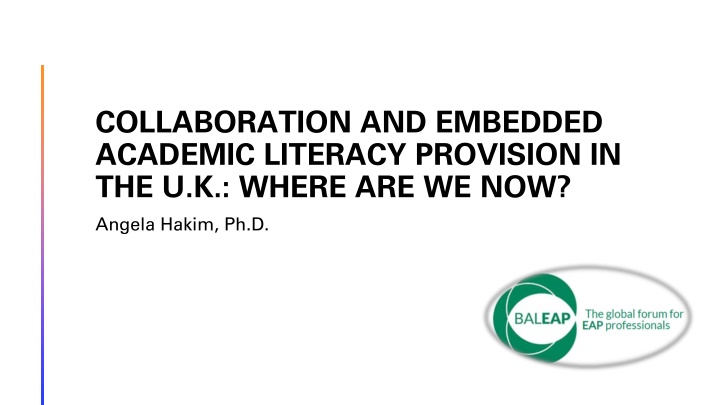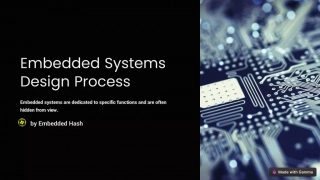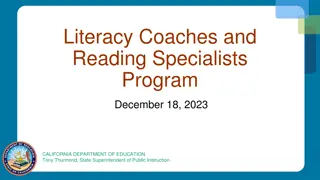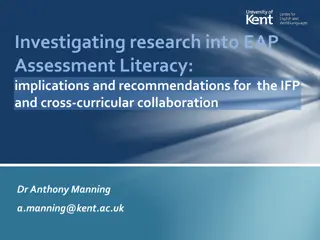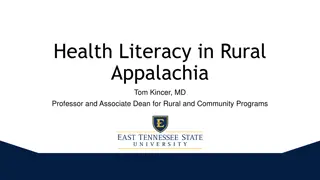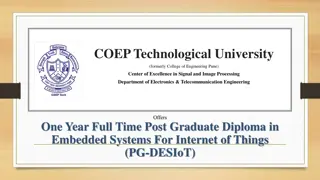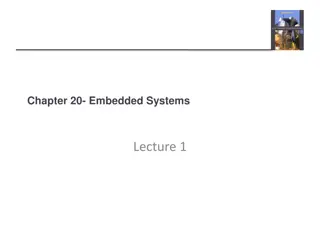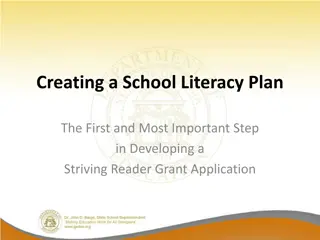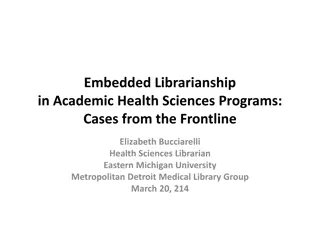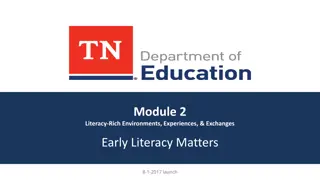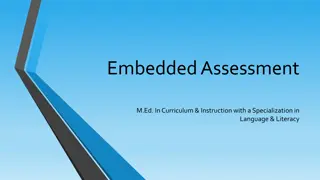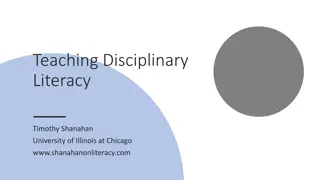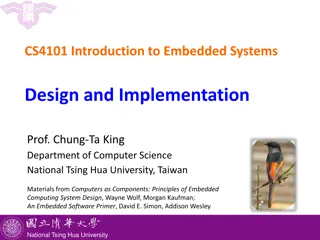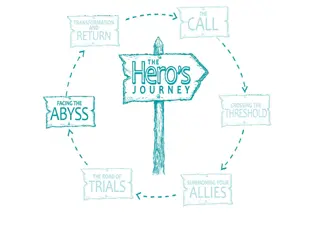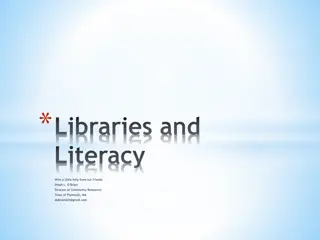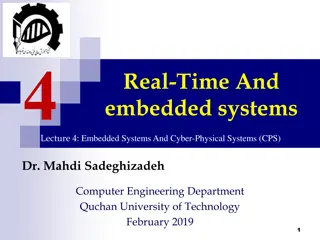Collaboration and Embedded Academic Literacy Provision in the U.K.
Academic literacy is crucial for student success, requiring integration into subject curricula. The research explores models of embedding and collaboration in U.K. universities, focusing on factors facilitating and hindering these practices.
Download Presentation

Please find below an Image/Link to download the presentation.
The content on the website is provided AS IS for your information and personal use only. It may not be sold, licensed, or shared on other websites without obtaining consent from the author.If you encounter any issues during the download, it is possible that the publisher has removed the file from their server.
You are allowed to download the files provided on this website for personal or commercial use, subject to the condition that they are used lawfully. All files are the property of their respective owners.
The content on the website is provided AS IS for your information and personal use only. It may not be sold, licensed, or shared on other websites without obtaining consent from the author.
E N D
Presentation Transcript
COLLABORATION AND EMBEDDED ACADEMIC LITERACY PROVISION IN THE U.K.: WHERE ARE WE NOW? Angela Hakim, Ph.D.
Acknowledgements Co-researcher Ursula Wingate, Ph.D.
Introduction Academic literacy fundamental to student success requires students to develop communicative competence in the discourse practices of their disciplines (Wingate, 2015) the need for academic literacy teaching to be integrated into subject curricula embedding academic literacy teaching
Literature Review Embedded instruction - teaching of academic language and literacy closely linked to the discipline and subject content Contrasts with generalized EAP provision Embedding ranges single workshops focused on preparing students for subject module assignments to instruction that is integrated into regular subject teaching. Murray (2022) soft to hard forms Published reports are scarce, and in-sessional (including embedded provision) remains hidden from view (Tibbetts & Chapman, 2023, p. 2).
Literature Review: Examples U.K. CEM Model Contextualization, embedding, and mapping (Sloan & Porter, 2010) Curriculum-integrated model (Wingate et al., 2011; Wingate, 2015) Lecturer Support Model EAP specialists and subject lecturer PD (McGrath et al., 2019; McGrath et al., 2023)
Literature Review: Obstacles Structural obstacles Position of EAP in universities Non-academic contracts and operating on the edge of academia (Ding & Bruce 2017) Conceptual obstacles Subject lecturers conceptualizations of AL (Murray, 2022) EAP as service providers (Tibbetts & Chapman, 2023) Overcoming obstacles through increased visibility Sharing examples Gathering cross-institutional and context-dependent factors
Research Questions 1. What models of embedding and collaboration exist in U.K. universities? 2. How are collaboration and embedded provision initiated? 3. Which factors facilitate collaboration and embedded provision? 4.What are the constraints and challenges to achieving and sustaining embedding?
Methods & Materials Approach: Qualitative approach Data Collection: Research conversations (Jenkins, 2013) with EAP specialists; a discussion among colleagues Participants: EAP specialists from fifteen U.K. universities 8 Russell Group universities 3 others 4 post-1992s A range of roles and titles (tutor, lecturer, or professor of academic language and literacies, EAP tutor, or learning development tutor) Data Analysis: Inductive analysis of the interview transcripts Iterative, collaborative, reflexive process to develop a preliminary code list and final code list
Preliminary Findings & Discussion: Main Themes Embedded Provision Factors that Constrain, Challenge, or Facilitate Collaboration & Embedding Initiation of Collaboration Models & Approaches to Embedding
Initiation of Collaboration discipline programme growth and/or demographic changes, as a result of EAP outreach, or because of institutional review
Extract 1 Discipline Growth and Demographic Changes So, quite often the conversations are a result of sort of a school has suddenly had an increase in international students and ... then there's a panic around sort of language level, and you know, there's a whole deficit sort of narrative coming from the school. (RG 5)
Extracts 2 & 3 Formal and Informal EAP Outreach I've presented now to four Deans of Teaching and Learning, and one Vice Chancellor, and we've got a new Vice Chancellor coming in and the Dean of Students and our Associate Deans for Teaching and Learning ... I've been to loads of Teaching and Learning committees, and people are interested. (P4) It comes through contacts that we have in conversations we have with lecturers who we speak to as peers and so they're running modules or they're running programmes, and they're people who invite us in because they respect what we're doing ... (P2)
Extract 4 Institutional Review So, our centre was implicated directly in the university's access and participation plan with closing that attainment gap So, we've always worked across the university with all kinds of students. But now because of the access and participation plan, there's a sort of strategic impetus top down for us to be working more explicitly with home students from certain backgrounds in addition to international students. (RG 1)
Models & Approaches to Embedding Embedded Provision Hard Soft Subject lecturer of delivery Co-teaching Collaboration Cooperation
Emerging Subject Lecturer Delivery So, there were a few modules where colleagues identified that there were problems with the use of sources of building the sources into the argument, and instead of us going in and doing a session, we kind of reviewed the materials used for their seminars over the trimester and picked out where we could add little tasks or just change the tasks a little bit to emphasize something related to literacies. And then discuss that with subject teaching staff, colleagues. And then they went off and umm and taught it (P1).
Emerging Subject Lecturer Delivery But I have a couple of examples or modules where rather than being asked to come and deliver material, I was asked to prepare material for sessions that the lecturers would then deliver to the students. And those sessions were on academic literacies and were linked to the assessments that this the lecturers were presenting to the student. So instead of doing a normal assessment brief that they would normally do, I've helped them develop materials around that brief, to flag up all the important considerations in in terms of academic literacy. So that happened on the post-graduate marketing module but also a foundation business module. So yeah, these are, I guess the best examples I can provide from Business School and law school (P2).
Emerging Subject Lecturer Delivery So, I worked with her for at least three years. And by the third year, there was, there was an occasion when I was sick, or the training, there was something happened, and I couldn't make it, and she did it She delivered the session. And she said, during the rest of the module, she realized she had been talking about a lot of the stuff anyway (P4).
Collaboration: Co-Teaching Collaboration may include joint development of materials and/or co-teaching in the same teaching session. This includes direct collaboration in linked courses or in the subject course (Hyland, 2019).
Collaboration: Co-Teaching And so as similar, it's a lot of our work is highly embedded ... it's very collaborative... So, what typically happens is the module leader will contact me and say you know, hey, we need to add a session on critical writing, let's say. So, we'll meet, or maybe we'll do it over email, and we'll chat about what are the specific needs of the students. And then I'll design the session and then we'll deliver it. And again, the emphasis will be very much and looking at text, making sure it's highly contextualized, the discipline, making sure that that the lecturer is coming in and adding further layers of context. So that's the kind of that's our bread and butter and that's the kind of core stuff that we do. (P1)
Collaboration: Co-teaching & Joint Feedback So, the feedback session is actually team teaching with the academics. We have two hours in the room. We give general feedback to the group. They do content. I do the other stuff - academic literacy stuff but it's team teaching, and it appears on their timetable as a module, a class. It just has my name attached to the teaching session, rather than the academic, but they see it very much as part of the module. (RG 8)
Collaboration: EAP staff AL Lecturers EAP specialist as AL lecturer in the subject course or in additional timetabled workshops; subject lecturer as collaborator on texts and tasks It's all in the student timetables and everything. And I deal directly with those subject lectures and the content, sometimes I attend a bit of the lecture just to sort of get a sense of how they are engaging with the idea. (O1)
Cooperation: Subject Lecturer as Informant Yeah, yeah. So, you'd normally have now normally run my materials past whoever my academic contact is, comments, and friendly suggestions or changes. So, when it works? Well, it works quite well... My academic contact is not keen to be coming along to the sessions. He's very good at suggesting things. So, you know, I'd work with him, and, you know, he'll say what's missing or what I should have look at, you know, so we do that very much I do the work, but he'll comment. (RG 2) We take quite a few rounds of the department to get them to engage with us and send their samples. (RG 4)
Factors that Constrain or Challenge Capacity Staff changes Service expectations Resistance to collaboration
Extract Capacity In fact, if that happened for every module, there just wouldn't, we wouldn't have the capacity I don't think as teaching intensive lecturers to really have that level of integration. (02)
Extract Staff Changes It's frustrating when ... programme leaders change and module leaders change, having to have the same conversations that you've had, you know, years ago and you think, Gosh, why, why haven't I seen that particular programme for so long? It's because there's a new lecturer doing something they just don't know about us or they don't think about us. (P2)
Extract Service Expectations We respond to the requests we get. We try and provide whatever we can and the point of need I think there was something this week or last week, and they asked, I think, on the Tuesday and wanted it on the Wednesday, and then this is often what happens, they are busy, busy, busy and then go, Yeah, oh yeah, can you do it tomorrow? (P2)
Factors that Facilitate Collaboration & Embedding Top-down support from university management Can fluctuate over time Importance of sustained EAP outreach Institutional agenda that reinforces support for embedded AL provision
Conclusions Embedded provision continues to increase in U.K. universities with emerging evidence of subject lecturer delivery, but it remains occluded, at risk of capacity challenges, and is vulnerable to staff changes. Overcoming the barriers to embedded provision oThe need for guidelines and frameworks for embedded provision, establishing and maintaining collaboration, and for handover and PD for subject lecturers to address capacity (McGrath et al., 2023) oContinued support from management requires continued EAP outreach and representation on boards and committees oOpportunities through institutional review and widening participation
References Ding, A. & Bruce, I. (2017). The English for Academic Purposes practitioner: Operating on the edge of academia. Palgrave Macmillan. Edwards, E., Goldsmith, R., Havery, C., & James, N. (2021). An institution-wide strategy for ongoing, embedded academic language development: Design, implementation and analysis. Journal of Academic Language and Learning 15 (1), 53 71. Hyland, K. (2019). English for Specific Purposes: Some influences and impacts. In X. Gao Second Handbook of ELT , pp. 337-354. Routledge. Jenkins, J. (2013). English as a lingua franca in the international university: The politics of academic English language policy. Taylor and Francis. McGrath, L., Donaghue, H., & Negretti, R. (2023). Embedding students academic writing development in early-career disciplinary lecturers practice. Journal of Academic Language and Learning, 17(1), 134-151. Retrieved from https://journal.aall.org.au/index.php/jall/article/view/939 McGrath, L., Negretti, R., & Nichols, K. (2019) Hidden expectations: Scaffolding subject specialists genre knowledge of the assignments they set. Higher Education, 78, 835-853. Murray, N. (2022). Embedding Academic Literacy in Degree Curricula. In Mohebbi, H., & Coombe, C. (eds.) Research Questions in Language Education and Applied Linguistics. Springer. Sloan, D., & Porter, E. (2010). Changing international student and business staff perceptions of in-sessional EAP: using the CEM model. Journal of English for Academic Purposes, 9(3), 198-210. https://doi.org/10.1016/j.jeap.2010.03.001 Tibbetts, N.A. & Chapman, T. (2023). A guide to in-sessional English for academic purposes: Paradigms and practices. Routledge. Wingate, U. (2018). Academic literacy across the curriculum: Towards a collaborative instructional approach. Language Teaching, 51(3), 349 364. Wingate, U. (2015). Academic literacy and student diversity: The case for inclusive practice. Multilingual Matters. Wingate, U., Andon, N., & Cogo, A. (2011). Embedding academic writing instruction into subject teaching: A case study. Active Learning in Higher Education, 12(1), 69-81. https://doi.org/10.1177/1469787410387814
Contact Angela Hakim, Ph.D. English Lecturer, Iowa State University Visiting Research Scholar, University of Arizona Email: angelahakim@arizona.edu ahakim@iastate.edu Profiles: LinkedIn Google Scholar ResearchGate
